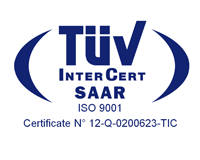Home > SGDP security policies
1.Purpose
The purpose of this procedure is to define specifics reported for the security policies adopted by the system
2.Applicability
This procedure applies to all activities involved in the SGDP
3.References
SGDP system
4.Responsibility and updating
The RSGDP is responsible for implementing this procedure.
5.Operational modes
5.1.1 SGDP security management policy
The objective of IT infrastructure security management is to ensure that systems, workstations, applications, network services, and processing services deliver processing performance at the defined levels and with the defined security requirements.
The general principles under which to put in place secure systems management are also summarized below:
An appropriate backup policy shall be prepared, possibly including remote backup, which of course shall be in accordance and consistent with the provisions of the preservation manual.
Supplier Security Policy.
With regard to the definition of security standards to be submitted to service providers who may play a decisive role in the SGDP, special letters of assignment are provided for each with the specifications to be implemented within the scope of the type of data to be processed on behalf of the Organization. Such processing must be guaranteed with appropriate security measures to be taken by the providers themselves.
5.1.2 Physical access control policy
Appropriate physical access control arrangements are in place, providing for, the following classes of access:
5.1.3 Policy for user entry and logical access control
How users are entered on the Organization’s information system, is assigned to the System Administrator (or if not provided by the SGDP manager), including the assignment of permissions for access to the organization’s systems, applications and applications;
The Administrator also provides the arrangements for deletion or change of authorization, with specific reference to the document retention system.
5.1.4 Workstation management policy
The essential elements of this policy are:
These activities are defined and implemented by the System Administrator (or if not provided for by the SGDP manager).
5.1.5 Application content management policy
Activities regarding system maintenance, checking the software content of clients in order to verify the absence of malicious code and compliance with what is authorized and provided for in the user licenses, is carried out by the System Administrator (or in case it is not provided for by the Resp Electronic Tools Maintenance – RMSE).
5.1.6 Policy on management, decommissioning and disposal of mobile equipment and media
Special attention is paid to the management of mobile devices (laptops, tablets, smartphones, cell phones, etc.) and media external to servers and workstations such as: External HDs/CDs/DVDs/Pen Drives/DAT/LTOs, etc., as well as printed paper, that are used and/or produced as part of document preservation activities.
The System Administrator (or in case it is not foreseen by the Resp Resp Electronic Instruments Maintenance – RMSE) defines the rules, as well as how to use and store the devices, including those for decommissioning/destroying the devices and media.
5.1.7 Communication channel management policy
Communication channels such as e-mail, instant messaging systems, VoIP, Internet, wireless access, fax machines, scanners, and photocopiers are controlled in order to preserve the confidentiality, and integrity of information in transit, and at the same time to prevent the misuse that could be made of such communication tools.
Accordingly, the type of controls covers issues of appropriate use of the instrument, issues of instrument user behavior, and the technologies involved.
5.1.8 Maintenance of security policies.
Provision is made for the refinement, disclosure and review of security policies upon the occurrence of the following cases:
In this regard, appropriate training is provided to all personnel of the Organization periodically.
Radiolabs
SEDE LEGALE E OPERATIVA
Corso d’Italia, 19 – 00198 Roma
T. 06 85380460
info@radiolabs.it
Politiche di sicurezza del SGDP
Powered by FCW © 2024

This website uses cookies to improve your experience while you navigate through the website.
Google Maps is a maps visualization service provided by Google Ireland Limited. This service is used to incorporate content of this kind on its pages.
Place of processing: Ireland - Privacy Policy
Gravatar is an image visualisation service provided by Automattic Inc. that allows this Website to incorporate content of this kind on its pages.
Place of processing: United States - Privacy Policy
Google Fonts is a service used to display font styles operated by Google Ireland Limited and serves to integrate such content into its pages.
Place of processing: Ireland - Privacy Policy
YouTube is a video content visualisation service provided by Google Ireland Limited. This service allows this Website to incorporate content of this kind on its pages.
This widget is set up in a way that ensures that YouTube will not store information and cookies about Users on this Website unless they play the video.
Place of processing: Ireland - Privacy Policy